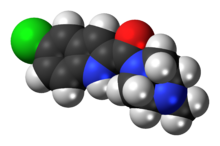 | |
 | |
| Clinical data | |
|---|---|
| Other names | 1--4-methylpiperazine |
| Identifiers | |
IUPAC name
| |
| CAS Number | |
| PubChem CID | |
| IUPHAR/BPS | |
| ChemSpider | |
| UNII | |
| ChEMBL | |
| CompTox Dashboard (EPA) | |
| ECHA InfoCard | 100.164.683 |
| Chemical and physical data | |
| Formula | C14H16ClN3O |
| Molar mass | 277.75 g·mol |
| 3D model (JSmol) | |
SMILES
| |
InChI
| |
| (what is this?) (verify) | |
JNJ-7777120 was a drug being developed by Johnson & Johnson Pharmaceutical Research & Development which acts as a potent and selective antagonist at the histamine H4 receptor. It has anti-inflammatory effects, and has been demonstrated to be superior to traditional (H1) antihistamines in the treatment of pruritus (itching). The drug was abandoned because of its short in vivo half-life and hypoadrenocorticism toxicity in rats and dogs, that prevented advancing it into clinical studies.
See also
References
- Jiang W, Lim HD, Zhang M, et al. (July 2008). "Cloning and pharmacological characterization of the dog histamine H(4) receptor". Eur. J. Pharmacol. 592 (1–3): 26–32. doi:10.1016/j.ejphar.2008.06.095. PMID 18639542.
- Thurmond RL, Desai PJ, Dunford PJ, Fung-Leung WP, Hofstra CL, Jiang W, Nguyen S, Riley JP, Sun S, Williams KN, Edwards JP, Karlsson L (Apr 2004). "A potent and selective histamine H4 receptor antagonist with anti-inflammatory properties". Journal of Pharmacology and Experimental Therapeutics. 309 (1): 404–13. doi:10.1124/jpet.103.061754. PMID 14722321. S2CID 8396875.
- Dunford PJ, Williams KN, Desai PJ, Karlsson L, McQueen D, Thurmond RL (Jan 2007). "Histamine H4 receptor antagonists are superior to traditional antihistamines in the attenuation of experimental pruritus". Journal of Allergy and Clinical Immunology. 119 (1): 176–83. doi:10.1016/j.jaci.2006.08.034. PMID 17208599.
- Thurmond RL, Venable J, Savall B, La D, Snook S, Dunford PJ, Edwards JP (2017). "Clinical Development of Histamine H4 Receptor Antagonists". Histamine and Histamine Receptors in Health and Disease. Handbook of Experimental Pharmacology. Vol. 241. pp. 301–320. doi:10.1007/164_2016_130. ISBN 978-3-319-58192-7. PMID 28233185.
| Piperazines | |
|---|---|
| Simple piperazines (no additional rings) | |
| Phenylpiperazines |
|
| Benzylpiperazines | |
| Diphenylalkylpiperazines (benzhydrylalkylpiperazines) |
|
| Pyrimidinylpiperazines | |
| Pyridinylpiperazines | |
| Benzo(iso)thiazolylpiperazines | |
| Tricyclics (piperazine attached via side chain) |
|
| Others/Uncategorized | |
This pharmacology-related article is a stub. You can help Misplaced Pages by expanding it. |